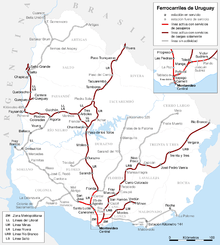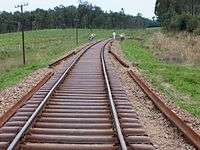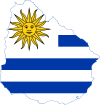Rail transport in Uruguay

The Uruguayan railway network has approximately 2900 km of lines, all of 1,435 mm (4 ft 8 1⁄2 in) gauge, diesel traction and only 11 km of double track. Half of the network is closed, freight trains circulating branches in Montevideo - Rivera - Livramento, Piedra Sola - Three Trees, Sayago - Minas, Verdum-Plant ANCAP, Carnelli-La Teja, Chamberlain - Paysandú - Salto - Concordia and Algorta - Fray Bentos. Work has been carried out to reopen the line from August 25 - San Jose -Ombucitos, having reopened the stretch to San Jose for passenger services in December 2006.[1]
- Overview
- Total rail network: 2,835 km
- Standard gauge: 1,435 mm (4 ft 8 1⁄2 in) – 2,835 km
- In service: 1,507 km
- Out of service: 1,328 km
History
The work of building the first railway line in Uruguay began April 25, 1867, a branch between Paso del Molino and Cerro which consisted of a horse-drawn train. The national "Ferrocarril Central" had obtained the concession for the laying of tracks to Durazno, 205 km from Montevideo. However, for more than a decade they had submitted projects to no avail. The first 18 kilometres (11 mi) branch between Bella Vista and Las Piedras, was inaugurated on 1 January 1869. To continue the extension of the line and due to lack of capital in the country, many loans were contracted in London, where, as a control, a directory was established. Due to financial problems and high costs of the national administration, the British acquired the majority stake. The Central Uruguay Railway, the largest British companies operating in the country, was formally born on 1 January 1878. By this time, several companies had appeared, such as the Midland Uruguay Railway. Although they were started by national capitals, they ended under British control as they were unable to find capital in the country to complete the works.

Nationalization
Following what was then a worldwide trend, the private companies were nationalised in 1948, the parliament approved the projects for the acquisition of foreign railroads, charging and part of the debt of 17 billion pounds that the United Kingdom had with Uruguay because of purchases made during the Second World War.
Narrow gauge
There were four big narrow gauge railway lines in Uruguay:
- Puerto del Sauce (now Juan Lacaze) - Terminal: 3 ft (914 mm), (1901–1959)
- Piriápolis - Pan de Azucar: 750 mm (2 ft 5 1⁄2 in) (1903–1958)
- km 393-Arrozal 33: 600 mm (1 ft 11 5⁄8 in)
- km 110 - Cantera Burgueño: 600 mm (1 ft 11 5⁄8 in).
All were dismantled. There were also several quarry lines of 600 mm (1 ft 11 5⁄8 in) gauge, among them the famous INDARE sand line. Around 300 m of that sand line is preserved and also a lot of steam locomotives. One of those is in working order. Also, a new narrow gauge line, of around 1 km, with two diesel locomotives from the former km 110 - Cantera Burgueño line, was constructed in a park on the town of Santiago Vazquez, west of Montevideo.
Passenger services
Regular passenger services are operated between Montevideo and Veinticinco de Agosto (63 km) since August 26, 1993 (previously all regular passenger services were withdrawn on January 2, 1988). One daily train was extended to San José de Mayo (96 km from Montevideo) on January 15, 2007, and other was extended from Veinticinco de Agostoo to Florida (109 km from Montevideo) on January 2, 2008. Another line, which operates between Montevideo and Estacion Ingeniero Victor Sudriers in Empalme Olmos, was reopened on December 15, 2005 (44 km).

Renovation plans
The state railway administration AFE has announced that starting January, 2010, 377 km of track will be renewed on the Pintado - Rivera railway of the central main line. The contract for the repair of railways covers in particular the section from Pintado (Florida) and Chamberlain (Tacuarembó) based on the change of wooden ties, and from there to Rivera on the border with Brazil, part of the international branch located along the border with the city of Santana do Livramento, in Rio Grande do Sul, Brazil using rail supplied by Russia given in lieu of a debt and wooden ties imported from Paraguay. The programme will cost US$30m.[2][3]
International links
-
 Argentina - 1,435 mm (4 ft 8 1⁄2 in) freight rail connection over the Salto Grande Dam. Passenger service was reinaugurated on this line on August 29, 2011,[4][5] using second-hand Dutch Wadloper trains; it closed again on May 2012.
Argentina - 1,435 mm (4 ft 8 1⁄2 in) freight rail connection over the Salto Grande Dam. Passenger service was reinaugurated on this line on August 29, 2011,[4][5] using second-hand Dutch Wadloper trains; it closed again on May 2012. -
 Brazil - break-of-gauge, 1,435 mm (4 ft 8 1⁄2 in) gauge (Uruguay) / 1,000 mm (3 ft 3 3⁄8 in) gauge (Santana do Livramento, Brazil).
Brazil - break-of-gauge, 1,435 mm (4 ft 8 1⁄2 in) gauge (Uruguay) / 1,000 mm (3 ft 3 3⁄8 in) gauge (Santana do Livramento, Brazil).
See also
| Wikimedia Commons has media related to Rail transport in Uruguay. |
References
- ↑ Ferrocarriles del Uruguay (In Spanish)
- ↑ "Pointers February 2009". Railway Gazette International. 2010-10-29.
- ↑ "Ayer se iniciaron las obras en la línea férrea Pintado-Rivera". 2010-10-30. (in Spanish)
- ↑ Tren Argentina - Uruguay 29/08/2011 (in Spanish). Retrieved 2011-10-29.
- ↑ Nuevo Servicio ferroviario Argentina - Uruguay. El Tren de los Pueblos Libres - Spot Publicitario. Retrieved 2011-10-29.
External links
- Winchester, Clarence, ed. (1936), "The trains of Uruguay", Railway Wonders of the World, pp. 1251–1255 illustrated description of the development of railways in Uruguay
